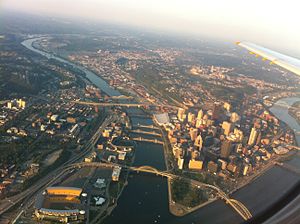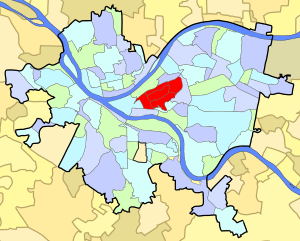Hill District facts for kids
Quick facts for kids
Hill District
|
|
|---|---|
|
Neighborhoods of Pittsburgh
|
|

The Hill District is the largely green area visible above downtown Pittsburgh in this aerial photo.
|
|

Location of the Hill District neighborhoods within the City of Pittsburgh
|
|
| Country | United States |
| State | Pennsylvania |
| County | Allegheny County |
| City | Pittsburgh |
The Hill District is a group of neighborhoods in Pittsburgh, Pennsylvania. For a long time, it has been a special place for African American culture. Before World War I, the Hill District was a major center for black life in Pittsburgh. It was also a very important place for jazz music.
Even though it was full of life and culture, a large part of the area was changed in the 1950s. This caused about 8,000 people to lose their homes.
Contents
Where is the Hill District?
The Hill District is located in Pittsburgh, Pennsylvania. In 2010, it included several areas called Census Tracts. These are like smaller sections of a city. The Hill District includes areas known as Crawford-Roberts (Lower Hill and Middle Hill), Upper Hill, Bedford Dwellings, and Terrace Village.
The Hill District is surrounded by other parts of Pittsburgh. To the west is Downtown. To the north are the Strip District and Polish Hill. To the southwest is the Bluff (Uptown). To the east and southeast is Oakland.
Local government leaders represent the Hill District. Most of the neighborhoods are part of City Council District 6. A small part of Upper Hill is also in District 7. The area uses the ZIP codes 15219 and 15213.
History of the Hill District
Early Days: "Little Haiti"
After Haiti became independent in 1804, many free African Americans settled in the Hill District. This community was Pittsburgh's oldest black neighborhood. It was even called "Little Haiti." The first residents of the Hill District were free black people who were middle-class. In 2004, Pittsburgh City Council celebrated Haiti's 200th anniversary.
The Great Migration Arrives
Starting in the 1910s, many new people moved to the Hill District. A lot of them came from the southern United States. This was part of a big movement called the Great Migration. People also came from other countries, like Italy and Eastern Europe.
The number of black residents grew very fast. It went from about 10,000 in 1890 to over 37,000 by 1920. So many new people needed homes. But strict rules about where black people could live meant they mostly had to stay in the Hill District. This caused a big housing problem.
Many young, single black men had trouble finding places to live. They often had to share small rooms in boarding houses. Sometimes, workers even slept in shifts. This meant one person would sleep during the day, and another would sleep in the same bed at night.
A Center of Culture (1920s-1950s)
The Hill District became a lively place for entertainment. It was a cultural center, especially for jazz music. Black business owners opened many nightclubs, bars, and other fun spots. These places always needed musicians to entertain their guests.
Many entertainment spots were located on Wylie Avenue, Fullerton Street, and Center Avenue. These places gave both famous national artists and new local musicians a chance to perform. Some well-known spots included:
- The Crawford Grill
- The Collins Inn
- The Humming Bird
- The Leader House
- The ToonTown Hub
- Derby Dan's
- Harlem Bar
- Musician's Club
- Sawdust Trail
- The Fullerton Inn
This strong entertainment scene helped jazz music grow in the neighborhood. Famous artists like Louis Armstrong and Duke Ellington often stopped in the Hill District on their tours. After a show at the Lincoln Tavern, "The Pittsburgh Courier" newspaper even called Ellington "the King of Jazz."
The lively music culture was very important for young jazz musicians from Pittsburgh. Historian Colter Harper noted that these venues were like training grounds. Young artists could practice, meet other musicians, get feedback from audiences, and find managers to help them perform in other cities.
Older musicians often helped younger ones. They shared career and music tips. For example, Mary Lou Williams, a famous jazz pianist from Pittsburgh, learned a lot from a touring artist named Jack Howard. She said his advice saved her "years and years to learn."
Because of its strong music culture, the Hill District was called "the Crossroads of the World." This phrase was first used by poet Claude McKay. It was made popular by Mary Dee, a radio DJ from WHOD Radio. This was Pittsburgh's only black radio station at the time.
Economic Changes
The Hill District was full of culture and successful businesses. But many of its homes were old and in poor condition. After World War II, the government wanted to improve housing across the country. In Pittsburgh, 95 acres of the Hill District were chosen for a big rebuilding project.
In 1943, City Council member George E. Evans thought this project would create jobs for soldiers returning from the war. He also believed it would fix what he saw as a run-down area. He wrote that most buildings in the Hill District were old and not useful anymore. He felt it would be no loss if they were all torn down.
Many older city homes did not have indoor plumbing or other basic things. Planners did not fully understand how much tearing down whole neighborhoods would affect the people living there. It broke up their communities and social connections.
Most Pittsburgh politicians agreed with Evans. This included state representative Homer S. Brown. Brown was the third African American to graduate from the University of Pittsburgh law school. He was very active in community work. He became a lawyer and led the local NAACP chapter. He served eight terms in the state government.
In the 1940s, Brown worked with leaders like David L. Lawrence and Richard King Mellon. They created laws for "urban renewal" in the Hill District. In the next ten years, Brown approved moving 1,500 black families. This made way for the Civic Arena. Later, he became the first African-American judge in Allegheny County.
In the summer of 1956, about 1,300 buildings were torn down. This forced about 1,500 families, or over 8,000 people, to move. Most of these people were black. This cleared space for the Civic Arena and its parking lots. The arena was built to bring big events and entertainment downtown.
However, this project cut off the Hill District from nearby neighborhoods. This led to a big decline in its economy. Pittsburgh's population also started to shrink. Jobs were lost as industries changed. Many middle-class families moved to newer homes in the suburbs. Between 1950 and 1990, the Hill District lost 71% of its residents. This was more than 38,000 people. About 400 businesses also closed.
Many people who moved from the Hill District went to the East Liberty and Homewood-Brushton neighborhoods. This also caused middle-class families in those areas to move to the suburbs.
The Hill District Today
Since the late 1900s, the city and community groups have been working to improve the Hill District. Because of job and business losses, many residents face poverty. The area has struggled for many years with rundown buildings and crime. About 40 percent of people in the Hill District live below the poverty line. Most residents today are black or African American. About 6 percent are white. For 30 years, residents did not have a supermarket. They also lacked a pharmacy for a long time.
A new grocery store opened in the Hill District in late 2013. It is part of Centre Heldman Plaza. This plaza also has places to eat and business services. The YMCA opened a new $9 million building in the neighborhood. It even has a garden on the roof.
A group of investors is working to restore the New Granada Theater. This was a historic jazz club where Ella Fitzgerald and Duke Ellington once performed. A new high school called the Hill House Passport Academy Charter School opened in 2014. It helps students who have dropped out of school. By 2016, 132 students had graduated. Duquesne University opened a new pharmacy in the neighborhood in December 2010. It was the first university-run community pharmacy in the United States.
Notable people
- Al Abrams, sportswriter
- Derrick Bell, civil rights lawyer and professor
- George Benson, jazz singer and guitarist
- Larry Brown, football player for the Washington Redskins
- Edward D. Gazzam, doctor and politician
- Gus Greenlee, businessman
- Charles Harris (photographer), photographer
- Sophie Masloff, Mayor of Pittsburgh (1988–1994)
- Bill Nunn, actor
- Aubrey Pankey, classical singer
- Stanley Turrentine, tenor saxophonist
- Cyril Wecht, forensic pathologist
- August Wilson, playwright
- Jimmy Wopo, rapper

